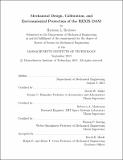Mechanical design, calibration, and environmental protection of the REXIS DAM
Author(s)
Bralower, Harrison L. (Harrison Louis)
DownloadFull printable version (18.09Mb)
Other Contributors
Massachusetts Institute of Technology. Department of Mechanical Engineering.
Advisor
David W. Miller, Rebecca A. Masterson and Warren P. Seering.
Terms of use
Metadata
Show full item recordAbstract
The REgolith X-ray Imaging Spectrometer (REXIS) is a joint effort by MIT and Harvard to build the student-collaboration experiment aboard OSIRIS-Rex, an asteroid sample return mission sponsored by the NASA New Frontiers program. OSIRISREx is scheduled to launch to near-Earth asteroid Bennu in 2016. REXIS is a coded-mask imaging X-ray spectrometer that supports the missions scientific goals by globally and spatially mapping the soft X-ray emission spectrum of Bennu. X-rays corresponding to unique elements are fluoresced from the asteroid by incident solar radiation and enter the instrument through a coded-aperture mask composed of a psuedorandom pinhole pattern. The X-rays that pass through the mask strike an array of four charge-coupled devices (CCDs) that detect the incident photon energy and location on the imaging array. A spatial map of selected elemental abundances on Bennu is constructed by cross-correlating the mask pattern with the collected data. The CCDs are integrated into a Detector Assembly Mount (DAM) that serves three critical functions: Mechanical alignment, calibration and protection of the CCDs. In this thesis we outline the overall design of the REXIS DAM with a focus on its three main functions. Chapter 1 provides background on the OSIRIS-REx mission and the REXIS instrument. Chapter 2 discusses the adaptation of the AXAF CCD Imaging Spectrometer (ACIS) focal plane mechanical design and X-ray Imaging Spectrometer (XIS) flexprint electrical design for the REXIS DAM. Chapter 3 outlines the heritage of the DAM internal calibration sources from XIS and the MIT MicroX project. Driving science and engineering considerations for a calibration scheme are described and then used to inform the mechanical design of a novel calibration set for the REXIS DAM. Chapter 4 illustrates the need for protection from the space environment and analyzes the specific risks to the detectors and DAM in space. Special coatings and a one-time deployable radiation shield are used to protect the assembly and ensure integrity of REXIS science data. Chapter 5 describes the test performed to validate the CCD alignment scheme and the dynamic model of the radiation cover. Chapter 6 summarizes the key results of the present work and outlines plans for future work on the DAM.
Description
Thesis: S.M., Massachusetts Institute of Technology, Department of Mechanical Engineering, 2013. This electronic version was submitted by the student author. The certified thesis is available in the Institute Archives and Special Collections. Cataloged from student-submitted PDF version of thesis. Includes bibliographical references (pages 167-172).
Date issued
2013Department
Massachusetts Institute of Technology. Department of Mechanical EngineeringPublisher
Massachusetts Institute of Technology
Keywords
Mechanical Engineering.